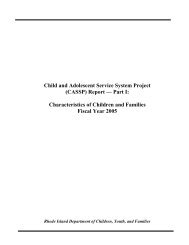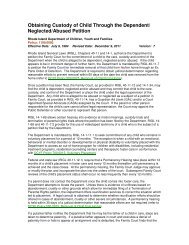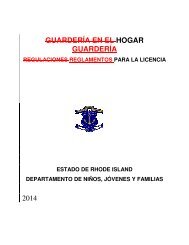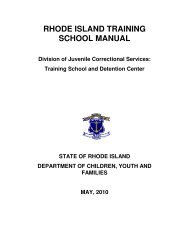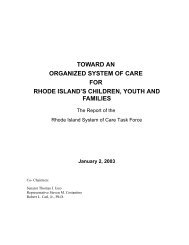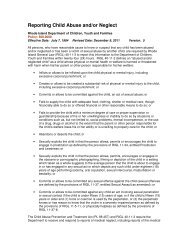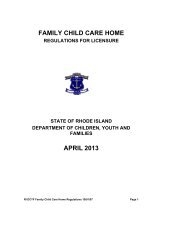system of care for rhode island's children, youth and families
system of care for rhode island's children, youth and families
system of care for rhode island's children, youth and families
You also want an ePaper? Increase the reach of your titles
YUMPU automatically turns print PDFs into web optimized ePapers that Google loves.
CHAPTER 1: EXECUTIVE SUMMARY<br />
Rhode Isl<strong>and</strong>’s organized Ideal System <strong>of</strong> Care <strong>for</strong> Children, Youth <strong>and</strong> Families is built on<br />
the strengths <strong>of</strong> <strong>families</strong> <strong>and</strong> communities, the successes <strong>of</strong> past initiatives, <strong>and</strong> is responsive<br />
to the challenges <strong>of</strong> the past. It is a <strong>system</strong> that is operationally feasible, financially realistic<br />
<strong>and</strong> supported by broad consensus. This <strong>system</strong> is a strategic instrument <strong>for</strong> moving the State<br />
closer to the four outcomes embraced by the Rhode Isl<strong>and</strong> Children’s Cabinet <strong>and</strong> other key<br />
state <strong>and</strong> community leaders:<br />
• All Children Entering School Ready To Learn<br />
• All Youth Leaving School Ready To Lead Productive Lives<br />
• All Children And Youth Safe In Their Homes, Neighborhoods And Schools<br />
• All Children Living In Families That Are Self-Sufficient, yet Interdependent<br />
The organized, ideal <strong>system</strong> is defined by the themes that follow <strong>and</strong> implemented through<br />
the identified strategies <strong>and</strong> processes which support these themes.<br />
THEME: FAMILY CENTERED PRACTICE – A FUNDAMENTAL SHIFT IN SERVICE DELIVERY<br />
The Ideal System supports the role <strong>of</strong> the family as the primary <strong>care</strong>giver <strong>for</strong> <strong>children</strong> <strong>and</strong><br />
recognizes that the optimum interventions <strong>for</strong> any individual child <strong>and</strong> their family are the<br />
interventions most proximate to home with the full resources <strong>of</strong> the community made<br />
available to that child <strong>and</strong> family (see Chapter 3 <strong>and</strong> Appendices B <strong>and</strong> D). It is critical to<br />
note that “<strong>families</strong>” include biological parents, adoptive <strong>families</strong>, extended kinship networks,<br />
legal guardians <strong>and</strong> temporary foster <strong>families</strong>. The broad vision is one in which a<br />
substantially greater portion <strong>of</strong> state resources are allocated to universal <strong>and</strong> selected<br />
prevention or early intervention services. However, the Ideal System acknowledges that<br />
substantial portions <strong>of</strong> the state’s limited resources must be focused to meet the immediate<br />
needs <strong>of</strong> identified priority populations.<br />
THEME: PREVENTION AND EDUCATION<br />
The <strong>system</strong>’s foundation is coordinated by local community members <strong>and</strong> state staff to<br />
ensure that all neighborhoods where <strong>families</strong> live have strong prevention <strong>and</strong> educational<br />
services <strong>and</strong> supports <strong>for</strong> the complex <strong>and</strong> changing needs <strong>of</strong> today’s <strong>children</strong> <strong>and</strong> <strong>families</strong>.<br />
It is a <strong>system</strong> which provides <strong>families</strong> <strong>and</strong> other <strong>care</strong>givers ready access to the resources<br />
necessary to meet <strong>children</strong>’s developmental needs. The <strong>system</strong> has mechanisms to redirect<br />
cost savings from reduced reliance on restrictive <strong>and</strong> expensive out-<strong>of</strong>-home placements to<br />
community-based prevention <strong>and</strong> intervention services. This is accomplished by shifting<br />
service delivery methods <strong>for</strong> these priority populations from a provider-driven, bed-based<br />
methodology to a culturally competent, family centered, community-based methodology<br />
that is school-linked, provides adequate state aid to achieve better outcomes, <strong>and</strong> integrates<br />
7





